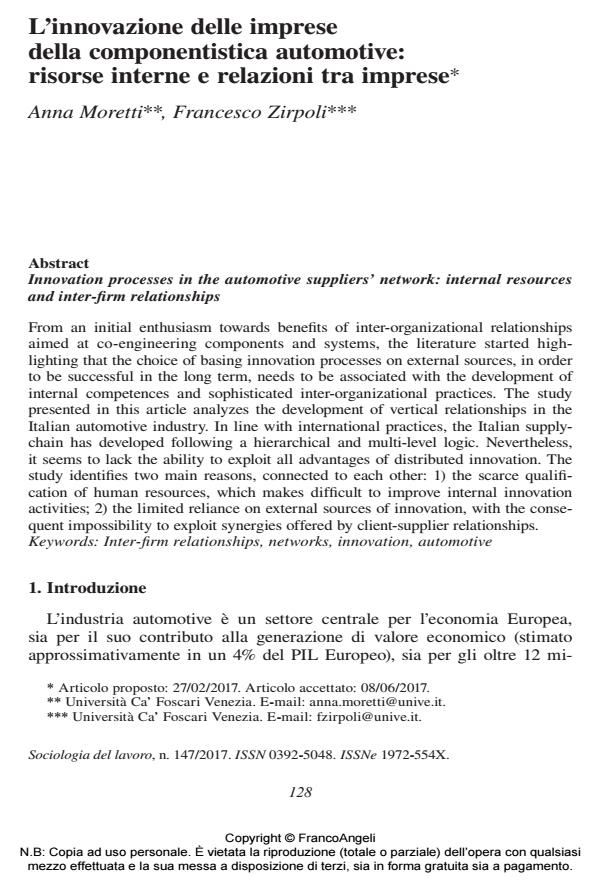L’innovazione delle imprese della componentistica automotive: risorse interne e relazioni tra imprese
Titolo Rivista SOCIOLOGIA DEL LAVORO
Autori/Curatori Anna Moretti, Francesco Zirpoli
Anno di pubblicazione 2017 Fascicolo 2017/147
Lingua Italiano Numero pagine 22 P. 128-149 Dimensione file 159 KB
DOI 10.3280/SL2017-147007
Il DOI è il codice a barre della proprietà intellettuale: per saperne di più
clicca qui
Qui sotto puoi vedere in anteprima la prima pagina di questo articolo.
Se questo articolo ti interessa, lo puoi acquistare (e scaricare in formato pdf) seguendo le facili indicazioni per acquistare il download credit. Acquista Download Credits per scaricare questo Articolo in formato PDF

FrancoAngeli è membro della Publishers International Linking Association, Inc (PILA)associazione indipendente e non profit per facilitare (attraverso i servizi tecnologici implementati da CrossRef.org) l’accesso degli studiosi ai contenuti digitali nelle pubblicazioni professionali e scientifiche
From an initial enthusiasm towards benefits of inter-organizational relationships aimed at co-engineering components and systems, the literature started highlighting that the choice of basing innovation processes on external sources, in order to be successful in the long term, needs to be associated with the development of internal competences and sophisticated inter-organizational practices. The study presented in this article analyzes the development of vertical relationships in the Italian automotive industry. In line with international practices, the Italian supplychain has developed following a hierarchical and multi-level logic. Nevertheless, it seems to lack the ability to exploit all advantages of distributed innovation. The study identifies two main reasons, connected to each other: 1) the scarce qualification of human resources, which makes difficult to improve internal innovation activities; 2) the limited reliance on external sources of innovation, with the consequent impossibility to exploit synergies offered by client-supplier relationships.
Parole chiave:Relazioni interorganizzative; reti di imprese; innovazione; automotive
- Osservatorio sulle trasformazioni dell’ecosistema automotive italiano 2022 Giuseppe Giulio Calabrese, (ISBN:978-88-6969-703-6)
- Governing Interorganizational Relationships for Innovation Stefano Li Pira, Anna Moretti, pp.71 (ISBN:978-3-031-50228-6)
- The financing methods for small and medium companies: comparison between Italy and Germany Matteo Rossi, Elisa Giacosa, Alberto Mazzoleni, in Corporate Ownership and Control /2016 pp.366
DOI: 10.22495/cocv13i3c2p9
Anna Moretti, Francesco Zirpoli, L’innovazione delle imprese della componentistica automotive: risorse interne e relazioni tra imprese in "SOCIOLOGIA DEL LAVORO " 147/2017, pp 128-149, DOI: 10.3280/SL2017-147007